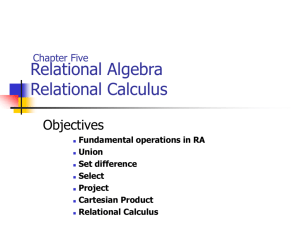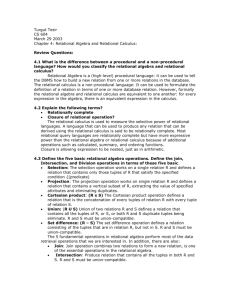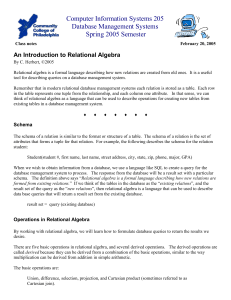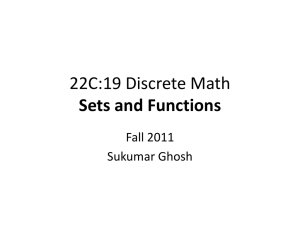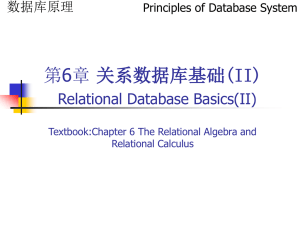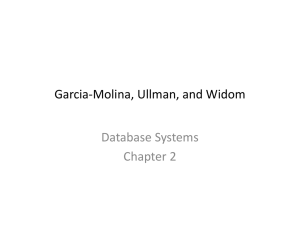Relational Algebra (Single table)
advertisement
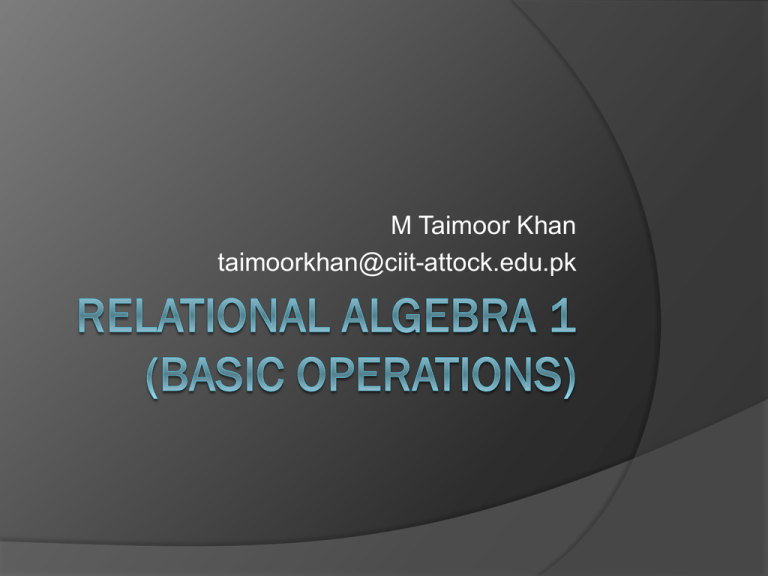
M Taimoor Khan taimoorkhan@ciit-attock.edu.pk Course Objectives 1) 2) 3) 4) 5) 6) 7) 8) 9) 10) 11) 12) 13) Basic Concepts Tools Database architecture and design Flow of data (DFDs) Mappings (ERDs) Formulating queries (Relational algebra) Implementing Schema Built-in Functions Extracting data Working with Joins Normalization Improving performance Advanced topics 6) Formulating queries (Relational algebra) o Basic Operations o Unary Operations o SELECT o PROJECT o Binary Operations o UNION o INTERSECTION o SUBTRACTION o CARTESIAN PRODUCT o JOINS o o o o o Theta JOIN EQUI JOIN NATURAL JOIN OUTER JOIN SEMI JOIN 6) Formulating queries (Relational algebra) o Basic Operations o Unary Operations o SELECT o PROJECT o Binary Operations o UNION o INTERSECTION o SUBTRACTION o CARTESIAN PRODUCT o JOINS o o o o o Theta JOIN EQUI JOIN NATURAL JOIN OUTER JOIN SEMI JOIN Lecture overview Five Basic Operators of Relational Algebra: Select Project Union Intersection Cartesian product 6) Formulating queries Relational Algebra The relational algebra is a procedural query language It consists of a set of operations that take one or two relations as input and produce a new relation as their result There are five basic operations of relational algebra. Unary Operations These are those operations, which involve only one relation or table These are: Select Project Binary Operations These are those operations, which involve pairs of relations and are, therefore called binary operations The input for these operations is two relations and they produce a new relation without changing the original relations These operations are: Union Set difference Cartesian product Select Operation The select operation is performed to select certain rows or tuples of a table, so it performs its action on the table horizontally The tuples are selected through this operation using a predicate or condition This command works on a single table and takes rows that meet a specified condition, copying them into a new table Denoted by lower Greek letter sigma (σ) Example Other operators In selection operation the comparison operators like <, >, =, <=, >=, <> can be used in the predicate Similarly, we can also combine several simple predicates into a larger predicate using the connectives and (^ ) and or (˅). Project Operation The Select operation works horizontally on the table on the other hand the Project operator operates on a single table vertically It produces a vertical subset of the table, extracting the values of specified columns, eliminating duplicates, and placing the values in a new table Project Operation It is unary operation that returns its argument relation, with certain attributes left out Since relation is a set any duplicate rows are eliminated Projection is denoted by a Greek letter (Π ) While using this operator all the rows of selected attributes of a relation are part of new relation Example Composition of relational operators The relational operators like select and project can also be used in nested forms iteratively As the result of an operation is a relation so this result can be used as an input for other operation Order is very important Example Binary Operations These are those operations, which involve pairs of relations and are, therefore called binary operations The input for these operations is two relations and they produce a new relation without changing the original relations These operations are: Union Set difference Cartesian product Union Operations The first requirement for union operator is that both the relations should be union compatible It means that relations must meet the following two conditions: Both the relations should be of same degree, which means that the number of attributes in both relations should be exactly same The domains of corresponding attributes in both the relations should be same. Union Operation It is denoted by U If R and S are two relations, which are union compatible, if we take union of these two relations then the resulting relation would be the set of tuples either in R or S or both Since it is set so there are no duplicate tuples The union operator is commutative which means: RUS=SUR Example Intersection Operation The intersection operation also has the requirement that both the relations should be union compatible i.e they are of same degree and same domains. It is represented by If R and S are two relations and we take intersection of these two relations then the resulting relation would be the set of tuples, which are in both R and S Just like union intersection is also commutative. R S=S R Example Set Difference Operation If R and S are two relations which are union compatible then difference of these two relations will be set of tuples that appear in R but do not appear in S. It is denoted by (-) Example Cartesian Product The Cartesian product needs not to be union compatible It means they can be of different degree It is denoted by X Suppose there is a relation R and S The Cartesian product will be: RXS It is also called cross product Example 6) Formulating queries (Relational algebra) Basic Operations Unary Operations SELECT PROJECT Binary Operations UNION INTERSECTION SUBTRACTION CARTESIAN PRODUCT o JOINS o o o o o Theta JOIN EQUI JOIN NATURAL JOIN OUTER JOIN SEMI JOIN Lab Activity-10 Hide columns Create relationships Next Lecture Relational Algebra 2 (Joins)
